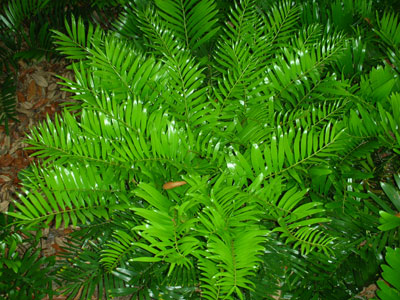Coontie
Zamia pumila
Family: Zamiaceae
Natural History
 Coontie growing in a yard near Tampa
Coontie growing in a yard near Tampa
Photo credit: Polly Perkins (Flickr ID polyphemus_polly).
Used under a Creative Commons license. ![]()
Coontie is the only cycad native to Florida. Like all cycads, it is a gymnosperm and doesn't produce any flowers or fruits. Instead, it reproduces by producing seeds in seed cones and pollen in pollen cones. The life cycle is similar to that of other gymnosperms, like pine trees and junipers.
For many years biologists were unsure about how many species of coontie existed in the southeastern U.S. and what scientific name(s) should be used for them. Today there seems to be a general agreement that there is just one species - Zamia pumila - but you can still find publications that use older names, including Zamia floridana and Zamia integrifolia.
Coonties grow as low, understory plants in the dry, well-drained areas of central Florida. They are often found in pine flatwoods and other places where pine trees predominate. The seeds of coontie are a food source for jays and other large birds, as well as for some small mammals. More importantly, the plant is a food source for the caterpillars of the atala, a butterfly that was once thought to be extinct.
The earliest residents in what is now Florida used coontie as a source of food. Although the plant is naturally poisonous to humans, members of the Seminole tribe developing a way of preparing the roots and underground stems so that the toxins were extracted and the remaining starch could be used for baking bread. In more recent years, residents of Florida have used coontie primarily as a landscaping plant. In fact, so many of the plants were collected out of Florida's forests in the 20th century that they became fairly rare. (This may be what led to the atala's brush with extinction.) Today the coonties used in landscaping come from native plant nurseries and collecting the plant in the wild is generally prohibited.
Most cycads come from tropical areas and cannot survive freezing temperatures. Apart from coontie, the only cycad commonly used in north Florida landscapes is sago palm (Cycas revoluta) which, despite the common name, is a cycad and not a palm.
